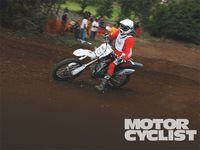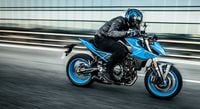The 2010 Red Bull Catalina Grand Prix was more than a happening and more than a motorcycle race. It was living history. And racing a 1962 Yamaha 250cc twin in Saturday’s vintage event and then a 2011 Yamaha YZ250F in Sunday’s 250 B event let me see just how far technology has advanced in 48 years. Turns out there’s virtually no connection, other than two wheels and a motor.
Giving credit where it’s due, the ’62 bike was surprisingly fast on the long, smooth fireroad section. Here, its willing engine and generous tire footprint gave it remarkable chops, and delivered a surprisingly fun riding experience. But the bike struggled over jumps and rough terrain, and low ground clearance was an issue. At 6 feet tall, I also found myself bunched up aboard the bike.
In comparison, the new YZ250F was omnipotent. Its four-stroke engine was super-revvy while still delivering tractable low-end and midrange power, further improved by an FMF MegaBomb header and Factory 4.1 titanium silencer with spark arrestor. All the controls worked lighter, quicker and better than on the old bike, but by far the greatest difference was the chassis. Perched high in a roomy cockpit and with a foot of fully adjustable suspension travel beneath me, the YZ250F could rush headlong into virtually any condition and handle it with aplomb. So rather than the rider having to help the bike, the bike helped the rider. Inarguably, that’s the pivotal difference between the old and new-bike riding experiences.
Old racers may lie, but numbers don’t. The 2011 YZ250F took me to a 15th place finish out of 48 riders in the 250 B class, a respectable result for a 50+ rider racing against a pack of youngsters, I thought. Which is why I was dumbfounded to learn that my best lap time aboard the new bike10 minutes, 44.468 secondswas just 58.6 seconds quicker than I had gone on the ’62 Ascot Scrambler replica the previous day! My conclusion is that the long, fast Catalina GP course favored building and keeping momentum more than outright heroics. But more importantly, it reinforced an age-old principle that deep down we all know is true: It’s not the size of the throttle; it’s how you twist it.

/cloudfront-us-east-1.images.arcpublishing.com/octane/D2BDYKKNZ5GRHGDMI4PZTGRMME.jpg)

/cloudfront-us-east-1.images.arcpublishing.com/octane/UAY4WSZPOFDQRP4MCEXAKDFQOQ.jpg)

/cloudfront-us-east-1.images.arcpublishing.com/octane/X5CE3KSJHZHM5CUFGPZ7U26WB4.jpg)
/cloudfront-us-east-1.images.arcpublishing.com/octane/COWLTPGFAFGDDGJCTENYMA4VJM.jpg)
/cloudfront-us-east-1.images.arcpublishing.com/octane/H3PKUGPSUJFTND4RFPSI4OIDCE.jpg)
/cloudfront-us-east-1.images.arcpublishing.com/octane/UHGQA3MQDFCA3HLBWF7S76WH6Y.jpg)
/cloudfront-us-east-1.images.arcpublishing.com/octane/Q5EORCSTNFAVBJC4IYUHIKJTXQ.jpg)
/cloudfront-us-east-1.images.arcpublishing.com/octane/XIJ5FUFSP5A3NL7MOVZGJXAHC4.jpg)
/cloudfront-us-east-1.images.arcpublishing.com/octane/V5NZN3CGS5B5PPYFYJHIPAU5S4.jpg)
/cloudfront-us-east-1.images.arcpublishing.com/octane/CZE6ONOBU5E7HPIEEADU376C4M.jpg)
/cloudfront-us-east-1.images.arcpublishing.com/octane/UT4KL3SIYJBSPNHWJXTBE6MTGE.jpg)
/cloudfront-us-east-1.images.arcpublishing.com/octane/Q3UOIDZ22ZEVDBZUWGJXIMGJKI.jpg)
/cloudfront-us-east-1.images.arcpublishing.com/octane/YQM66WXZV5AAXNNOIUVOGVXZMY.jpg)
/cloudfront-us-east-1.images.arcpublishing.com/octane/J47NFTXNLFFGHELHZCUD2LCITA.jpg)
/cloudfront-us-east-1.images.arcpublishing.com/octane/NXPQBTLX3NCILKQ2GCFJYNIDEM.jpg)
/cloudfront-us-east-1.images.arcpublishing.com/octane/6U7NJLAYMRBZTIGNKWIA5OK2FQ.jpg)
/cloudfront-us-east-1.images.arcpublishing.com/octane/IYTZQWUROVC25IMTDEWUDQ5IQE.jpg)
/cloudfront-us-east-1.images.arcpublishing.com/octane/YJODDXEL2ZB5TENKPPN4BEYJAE.jpg)
/cloudfront-us-east-1.images.arcpublishing.com/octane/QEQQUZYNJFAIJB4DZFVFSNTCQ4.jpg)
/cloudfront-us-east-1.images.arcpublishing.com/octane/F4EEHDT3UZFKPLKVGDWMMPFEQE.jpg)
/cloudfront-us-east-1.images.arcpublishing.com/octane/J47U6OWNLBFBBG75A3ILAKFYZU.jpg)
/cloudfront-us-east-1.images.arcpublishing.com/octane/XWWQYTL3J5B7LKXDI354FFF4NQ.jpg)